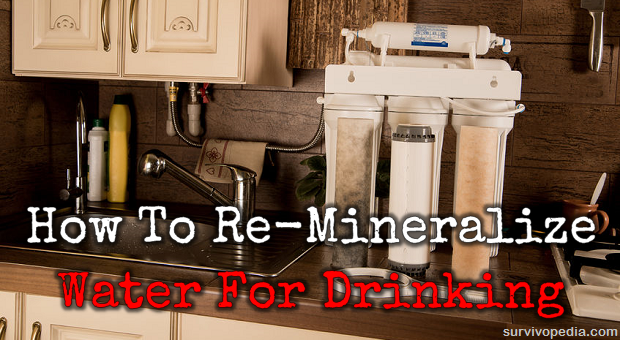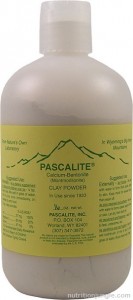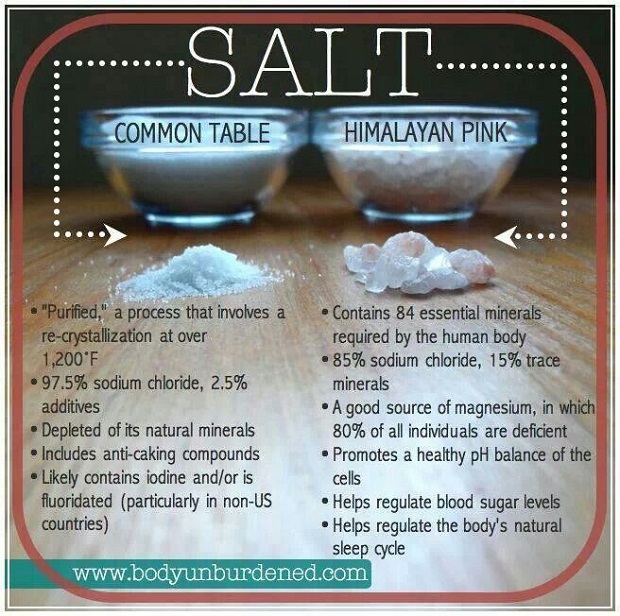 The debate about the health benefits of purified versus distilled water is a hot one. There are those who claim that they feel tons better since switching to distilled water and there are those that claim that distilled water is the devil.
The debate about the health benefits of purified versus distilled water is a hot one. There are those who claim that they feel tons better since switching to distilled water and there are those that claim that distilled water is the devil.
The purpose here isn’t to discuss that debate; it’s simply to provide some options for those who want to know how to re-mineralize water for drinking.
Why Would You Need to Re-Mineralize Water?
Water already has minerals in it, right? Well, yes but not after it’s been distilled or purified using reverse osmosis. Both of those processes remove most of the impurities – up to 99.5% of them – from the water. The purification process is indiscriminate, though. It removes the “good” minerals along with the bad stuff. Proponents of re-mineralizing water advocate the process for a few different reasons.
- You need the minerals, especially if you’re not eating properly or you’ve been out in the heat sweating. The primary minerals that your body needs to replenish are calcium, magnesium, potassium and salt, though there are many others, too.
- Re-mineralized water quenches thirst better and is absorbed by your body faster. This is a point of contention but the argument for faster hydration states that adding minerals back into the water boosts the pH and brings it back to an alkaline state. The water becomes ionized, which makes the water molecules cluster into smaller groups, which makes it easier for your body to absorb.
- Re-mineralized water tastes better. Though this is subjective, it’s true that the human palate is used to the flavor of water with minerals in it. It gives it a fuller flavor (that is to say, it gives it SOME flavor) that many people find preferable to distilled water.
Now that you know WHY some people prefer to re-mineralize water, let’s talk about how to do it. There are a few different ways that you can re-mineralize your water but since we love to do things on a budget, we’re going to discuss the ones that are wallet-friendly.
Buy a Reverse Osmosis System that Re-Mineralizes for You
You can also buy after-market re-mineralizing cartridges to your existing system. Just do a quick search on the internet and you’ll find what you need. They cost about $50. If you can find a less expensive one, please mention it in the comments section below.
Add a Pinch of Celtic or Himalayan Salt to Your Water
Celtic sea salt adds about 80 different vital trace minerals to your water. You want to use the grey kind that sticks to the sides of the container. Himalayan salt is the pink salt that you often see in gourmet stores. It contains about the same number of minerals as Celtic sea salt but they do taste a bit different.
However, since you’re just putting a pinch in your water, taste isn’t going to be an issue. Himalayan salt also has a bit less sodium in it. Use either of these that you would like but stay away from table salt; that stuff is horrible for you.
Add a Pinch of Pascalite Clay to Your Water to Re-Mineralize It
This clay comes from high up in Wyoming’s Big Horn Mountains. It’s classified as a white clay but is actually cream-colored. It’s rich in natural minerals and won’t affect the flavor of your water. Bentonite could work too.
As a side note, Pascalite also has purported medicinal properties including being good for burns, bug bites, infections, rashes, acne, cuts and scrapes. It’s also used in mud bathes for detoxifying and softening skin and can even be used as a natural deodorant or body powder. Native Americans actually called it The Mud That Heals. How’s that for multi-purpose?
Use Mineral Drops or Tablets to Re-Mineralize Your Water
There are actually commercial drops that you can use to add the minerals back in to your water. One brand is ConcenTrace and another is Sea MD. An 8oz bottle of ConcenTrace will run you about 15 bucks on Amazon and it states that it has 72 mineral in it. Sea MD will cost you about $20 for 4oz.
Mineral tablets may be another option for you to consider. You can get 300 ConcenTrace tablets on Amazon for about $23.
Now You Know
As you can see, there are several different methods that you can use to re-mineralize your water. The drops and the tablets are probably your best option for your bug-out bags or to store in your stockpile but for now, the filters or entire system may be more convenient and cost efficient since you don’t have to add something to your water every time that you pour a glass or crack a bottle.
If you’re buying bottled water from a store while you’re out, there are a few brands that are properly re-mineralized including Fiji, Evian, Vittel, Volvic and Trinity. These may be brands that you wish to consider storing in your stockpile if minerals in your water are important to you. It’s certainly the easiest method of re-mineralizing your water though it may not be quite as cost effective – those are some of the pricier brands of bottled water.
To be honest, most of your minerals come from your food. The only time that minerals in water become seriously important is if you’re not eating a balanced meal that provides all of the nutrients that you need. Even then, the minerals in water are there in trace amounts. If you absolutely can’t afford any of these options, purified water will be fine.
We hope that you’ve learned what you needed from this article. If you have anything that you’d like to add, please let us know what you’re thinking in the comments section below!
This article has been written by Theresa Crouse for Survivopedia.
About Theresa Crouse
Theresa Crouse is a full-time writer currently living in central Florida. She was born and raised in the hills of West Virginia, where she learned to farm, hunt, fish, and live off the land from an early age. She prefers to live off the grid as much as possible and does her best to follow the “leave nothing behind but footprints” philosophy. For fun, she enjoys shooting, kayaking, tinkering on her car and motorcycle, and just about anything else that involves water, going fast, or the outdoors. You can send Theresa a message at theresa.crouse [at] survivopedia.com.




